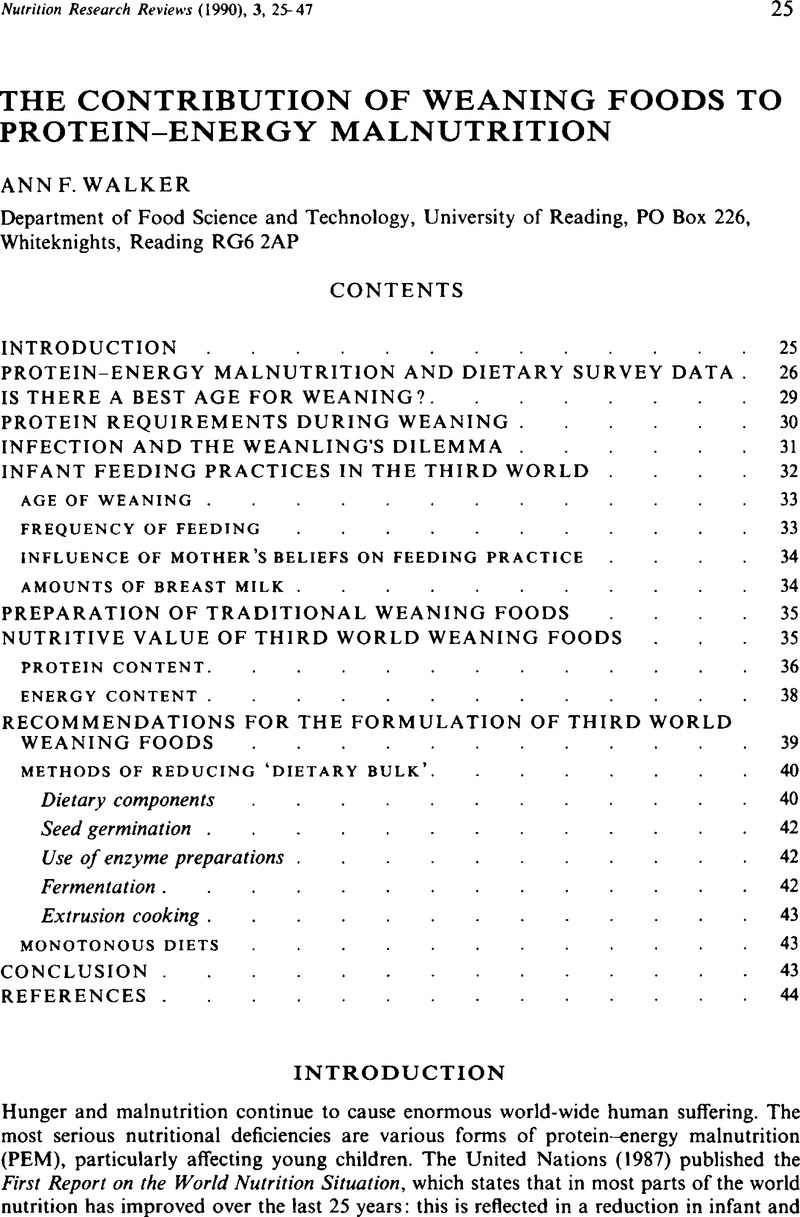Crossref Citations
This article has been cited by the following publications. This list is generated based on data provided by Crossref.
Jones, C. D. R.
1991.
Weaning food mythology.
British Journal of Nutrition,
Vol. 66,
Issue. 2,
p.
351.
Filteau, Suzanne
and
Tomkins, Andrew
1994.
Infant Nutrition.
p.
143.
Draper, Alizon
1994.
Infant Nutrition.
p.
209.
Gibson, Rosalind S.
1994.
Zinc Nutrition in Developing Countries.
Nutrition Research Reviews,
Vol. 7,
Issue. 1,
p.
151.
Nap, R.C.
and
Hazewinkel, H.A.W.
1994.
Growth and skeletal development in the dog in relation to nutrition; a review.
Veterinary Quarterly,
Vol. 16,
Issue. 1,
p.
50.
Maggioni, Andrea
and
Lifshitz, Fima
1995.
Nutritional Management of Failure to Thrive.
Pediatric Clinics of North America,
Vol. 42,
Issue. 4,
p.
791.
Kikafunda, Joyce K.
Walker, Ann F.
and
Abeyasekera, Savitri
1997.
Optimising viscosity and energy density of maize porridges for child weaning in developing countries.
International Journal of Food Sciences and Nutrition,
Vol. 48,
Issue. 6,
p.
401.
Kikafunda, Joyce K.
Walker, Ann F.
and
Gilmour, Steven G.
1998.
Effect of refining and supplementation on the viscosity and energy density of weaning maize porridges.
International Journal of Food Sciences and Nutrition,
Vol. 49,
Issue. 4,
p.
295.
Prentice, Andrew M
and
Paul, Alison A
2000.
Fat and energy needs of children in developing countries.
The American Journal of Clinical Nutrition,
Vol. 72,
Issue. 5,
p.
1253s.
Warren, Rueben
and
Enwonwu, Cyril
2000.
Nutrition and AIDS, Second Edition.
Vol. 20002265,
Issue. ,
p.
175.
Rombo, George O
Taylor, John R N
and
Minnaar, Amanda
2001.
Effect of irradiation, with and without cooking of maize and kidney bean flours, on porridge viscosity and in vitro starch digestibility.
Journal of the Science of Food and Agriculture,
Vol. 81,
Issue. 5,
p.
497.
Onyango, Adelheid Werimo
2002.
Short and Long Term Effects of Breast Feeding on Child Health.
Vol. 478,
Issue. ,
p.
151.
Kruger, R
and
Gericke, GJ
2003.
A qualitative exploration of rural feeding and weaning practices, knowledge and attitudes on nutrition.
Public Health Nutrition,
Vol. 6,
Issue. 2,
p.
217.
Folayan, M.O.
2004.
The Epidemiology, Etiology, and Pathophysiology of Acute Necrotizing Ulcerative Gingivitis Associated with Malnutrition.
The Journal of Contemporary Dental Practice,
Vol. 5,
Issue. 3,
p.
28.
Oumarou, Habiba
Ejoh, Richard
Ndjouenkeu, Robert
and
Tanya, Agatha
2005.
Nutrient Content of Complementary Foods Based on Processed and Fermented Sorghum, Groundnut, Spinach, and Mango.
Food and Nutrition Bulletin,
Vol. 26,
Issue. 4,
p.
385.
Mosha, Theobald CE
and
Bennink, Maurice R
2005.
Protein digestibility‐corrected amino acid scores, acceptability and storage stability of ready‐to‐eat supplementary foods for pre‐school age children in Tanzania.
Journal of the Science of Food and Agriculture,
Vol. 85,
Issue. 9,
p.
1513.
MOSHA, THEOBALD C.E.
and
VICENT, MARY M.
2005.
NUTRITIONAL QUALITY, STORAGE STABILITY AND ACCEPTABILITY OF HOME-PROCESSED READY-TO-EAT COMPOSITE FOODS FOR REHABILITATING UNDERNOURISHED PRESCHOOL CHILDREN IN LOW-INCOME COUNTRIES.
Journal of Food Processing and Preservation,
Vol. 29,
Issue. 5-6,
p.
331.
Mosha, Theobald C.E.
Bennink, Maurice R.
and
NG, Perry K.W.
2005.
Nutritional Quality of Drum-processed and Extruded Composite Supplementary Foods.
Journal of Food Science,
Vol. 70,
Issue. 2,
p.
C138.
Kikafunda, Joyce K.
Abenakyo, Loy
and
Lukwago, Fred B.
2006.
Nutritional and Sensory Properties of High Energy/Nutrient Dense Composite Flour Porridges from Germinated Maize and Roasted Beans for Child-Weaning in Developing Countries: A Case for Uganda.
Ecology of Food and Nutrition,
Vol. 45,
Issue. 4,
p.
279.
Joffe, Michael
2007.
Health, Livelihoods, and Nutrition in Low-Income Rural Systems.
Food and Nutrition Bulletin,
Vol. 28,
Issue. 2_suppl2,
p.
S227.



